Responses of the Distribution Pattern of the Suitable Habitat of Juniperus tibetica Komarov to Climate Change on the Qinghai-Tibet Plateau
Abstract
:1. Introduction
2. Materials and Methods
2.1. Species Distribution Point Records
2.2. Collection of Environmental Data
2.3. Selecting of Environmental Factors
2.4. Simulation and Evaluation of the Model
2.5. Standard Deviation Elliptic Analysis
2.6. Multivariate Environmental Similarity Surface (MESS) and the Most Dissimilar (MoD) Variable Analysis
3. Results
3.1. Environmental Factors Affecting the DPSH of J. tibetica
3.2. DPSH of J. tibetica under Three Climatic Conditions
3.3. Temporal and Spatial Evolution of the Suitable Habitat of J. tibetica
3.4. Regions of Environmental Anomalies Caused by Climate Change
4. Discussion
4.1. Correlations between Climatic Factors and DPSH of J. tibetica
4.2. Response of DPSH of J. tibetica to Climate Change and the Selection of Climate Model
4.3. Implications
5. Conclusions
Author Contributions
Funding
Data Availability Statement
Conflicts of Interest
References
- IPCC 2022. Climate Change 2022: Mitigation of Climate Change, the Working Group III Contribution; Sixth Assessment Report; IPCC: Geneva, Switzerland, 2022. [Google Scholar]
- Klein, J.A.; Harte, J.; Zhao, X.Q. Experimental warming causes large and rapid species loss, dampened by simulated grazing, on the Tibetan Plateau. Ecol. Lett. 2004, 7, 1170–1179. [Google Scholar] [CrossRef]
- Kuang, X.; Jiao, J. Review on climate change on the Tibetan Plateau during the last half century. J. Geophys. Res. Atmos. 2016, 121, 3979–4007. [Google Scholar] [CrossRef] [Green Version]
- Gao, Q.; Guo, Y.; Xu, H.; Ganjurjav, H.; Li, Y.; Wan, Y.; Qin, X.; Ma, X.; Liu, S. Climate change and its impacts on vegetation distribution and net primary productivity of the alpine ecosystem in the Qinghai-Tibetan Plateau. Sci. Total Environ. 2016, 554, 34–41. [Google Scholar] [CrossRef] [PubMed]
- Liang, E.; Leuschner, C.; Dulamsuren, C.; Wagner, B.; Hauck, M. Global warming-related tree growth decline and mortality on the north-eastern Tibetan plateau. Clim. Chang. 2016, 134, 163–176. [Google Scholar] [CrossRef]
- Yang, B.; He, M.; Shishov, V.; Tychkov, I.; Vaganov, V.; Rossi, S.; Ljungqvist, F.C.; Bräuning, A.; GrieBinger, J. New perspective on spring vegetation phenology and global climate change based on Tibetan Plateau tree-ring data. Proc. Natl. Acad. Sci. USA 2017, 114, 6966–6971. [Google Scholar] [CrossRef] [Green Version]
- Xu, Z.; Peng, H.; Peng, S. The development and evaluation of species distribution models. Acta Ecol. Sin. 2015, 35, 558–567. [Google Scholar]
- Peterson, A.T.; Papes, M.; Eaton, M. Transferability and model evaluation in ecological niche modeling: A comparison of GARP and Maxent. Ecography 2007, 30, 550–560. [Google Scholar] [CrossRef]
- Xing, D.; Hao, Z. The principle of maximum entropy and its applications in ecology. Biodivers. Sci. 2011, 19, 295–302. [Google Scholar]
- Zhang, Y.; Tang, J.; Ren, G.; Wang, X. Global potential distribution prediction of Xanthium italicum based on Maxent model. Sci. Rep. 2021, 11, 16545. [Google Scholar] [CrossRef]
- Sun, X.; Long, Z.; Jia, J. A multi-scale Maxent approach to model habitat suitability for the giant pandas in the Qionglai mountain, China. Glob. Ecol. Conserv. 2021, 30, 1766. [Google Scholar] [CrossRef]
- Wan, J.; Qi, G.; Ma, J.; Ren, Y.; Wang, R.; McKirdy, S. Predicting the potential geographic distribution of Bactrocera bryoniae and Bactrocera neohumeralis (Diptera: Tephritidae) in China using MaxEnt ecological niche modeling. J. Integr. Agric. 2020, 19, 2072–2082. [Google Scholar] [CrossRef]
- Shao, W.; Jiang, F.; Huang, L.; Wang, X. Risk Assessment of Canine Distemper in the Distribution Area of Giant Panda in Sichuan, Shaanxi and Gansu Provinces, China. J. Risk Anal. Crisis Response 2017, 7, 225–229. [Google Scholar] [CrossRef] [Green Version]
- Guevara, L.; Gerstner, B.E.; Kass, J.M.; Anderson, R.P. Toward ecologically realistic predictions of species distributions: A cross-time example from tropical montane cloud forests. Glob. Chang. Biol. 2018, 24, 1511–1522. [Google Scholar] [CrossRef] [PubMed]
- Russell, J.; Zonneveld, V.M.; Dawson, I.K.; Booth, A.; Waugh, R.; Steffenson, B. Genetic Diversity and Ecological Niche Modelling of Wild Barley: Refugia, Large-Scale Post-LGM Range Expansion and Limited Mid-Future Climate Threats? PLoS ONE 2014, 9, e86021. [Google Scholar] [CrossRef] [Green Version]
- Pearson, R.G.; Raxworthy, C.J.; Nakamura, M.; Peterson, A.T. Predicting species distributions from small numbers of occurrence records: A test case using cryptic geckos in Madagascar. J. Biogeogr. 2007, 34, 102–117. [Google Scholar] [CrossRef]
- Roura-Pascual, N.; Brotons, L.; Peterson, A.T.; Thuiller, W. Consensual predictions of potential distributional areas for invasive species: A case study of Argentine ants in the Iberian Peninsula. Biol. Invasions 2009, 11, 1017–1031. [Google Scholar] [CrossRef]
- Cao, X.; Wang, J.; Zhang, X. Simulation of the potential distribution patterns of Picea crassifolia in climate change scenarios based on the maximum entropy (Maxent) model. Acta Ecol. Sin. 2019, 39, 5232–5240. [Google Scholar]
- Wei, Y.; Zhang, L.; Wang, J.; Wang, W.; Niyati, N.; Guo, Y.; Wang, X. Chinese caterpillar fungus (Ophiocordyceps sinensis) in China: Current distribution, trading, and futures under climate change and overexploitation. Sci. Total Environ. 2021, 755, 142548. [Google Scholar] [CrossRef]
- Han, M.; Bai, Q.; Sun, S.; Yan, J.; Zhang, C.; Zhang, C.; Zhang, J.; You, M.; Li, D.; Yan, X. Simulation of Elymus sibiricus L. Distribution in Tibetan Plateau Based on MaxEnt Model. Acta Agrestia Sin. 2021, 29, 374–382. [Google Scholar]
- Kou, J.; Wang, T.; Yu, F.; Sun, Y.; Feng, C.; Shao, X. The moss genus Didymodon as an indicator of climate change on the Tibetan Plateau. Ecol. Indic. 2020, 113, 106204. [Google Scholar] [CrossRef]
- Guo, Y.; Wei, H.; Lu, C.; Zhang, H.; Guo, W. Predictions of potential geographical distribution of Sinopodophyllum hexandrum under climate change. Chin. J. Plant Ecol. 2014, 38, 249–261. [Google Scholar]
- Hu, Z.; Guo, K.; Jin, S.; Pan, H. The influence of climatic changes on distribution pattern of six typical Kobresia species in Tibetan Plateau based on MaxEnt model and geographic information system. Theor. Appl. Climatol. 2019, 135, 375–390. [Google Scholar] [CrossRef]
- Wang, W.; Tang, X.; Zhu, Q.; Pan, K.; Hu, Q.; He, M.; Li, J. Predicting the Impacts of Climate Change on the Potential Distribution of Major Native Non-Food Bioenergy Plants in China. PLoS ONE 2014, 9, e111587. [Google Scholar] [CrossRef] [PubMed]
- Hu, Z.; Zhang, Y.; Yu, H. Simulation of Stipa purpurea distribution pattern on Tibetan Plateau based on MaxEnt model and GIS. J. Appl. Ecol. 2015, 26, 505–511. [Google Scholar]
- Jin, Y.; Wang, H.; Wei, L.; Hou, Y.; Hu, J.; Wu, K.; Xia, H.; Xia, J.; Zhou, B.; Li, K.; et al. A plot-based dataset of plant community on the Qingzang Plateau. Chin. J. Plant Ecol. 2022, 46, 846–854. [Google Scholar] [CrossRef]
- Zhu, Q.; Ning, P.; Hou, L.; Hao, J.; Hu, Y. Characteristics of Juniperus community types in the Three-River-Source Region. Chin. J. Plant Ecol. 2022, 46, 114–122. [Google Scholar]
- Miao, J.; Tso, S.; Li, J.; Xie, S.; Mao, K. The complete chloroplast genome of Juniperus tibetica (Cupressaceae), the conifer that occupies the highest known treeline in the Northern Hemisphere. Mitochondrial DNA Part B 2019, 4, 609–611. [Google Scholar] [CrossRef] [Green Version]
- Georg, M.; Sabine, M.; Jonas, V.; Sonam, C.; Duo, L. Highest treeline in the northern hemisphere found in southern Tibet. Mt. Res. Dev. 2007, 27, 169–173. [Google Scholar]
- Shi, P.; Ning, W.; Rawat, G.S. The Distribution Patterns of Timberline and Its Response to Climate Change in the Himalayas. J. Resour. Ecol. 2020, 11, 342–348. [Google Scholar]
- Wang, X. Study on Pollination Characteristics of Sabina tibetica (in Chinese). J. Gansu For. Sci. Technol. 2020, 45, 14–16. [Google Scholar]
- Lu, X.; Zheng, G. Habitat selection and use by a hybrid of white and Tibetan eared pheasants in eastern Tibet during the post-incubation period. Can. J. Zool. 2001, 79, 319–324. [Google Scholar] [CrossRef]
- Salvà-Catarineu, M.; Romo, A.; Mazur, M.; Zielińska, M.; Minissale, P.; Dönmez, A.A.; Boratyńska, K.; Boratyński, A. Past, present, and future geographic range of the relict Mediterranean and Macaronesian Juniperus phoenicea complex. Ecol. Evol. 2021, 11, 5075–5095. [Google Scholar] [CrossRef]
- Naudiyal, N.; Wang, J.; Ning, W.; Gaire, N.P.; Shi, P.; Wei, Y.; He, J.; Shi, N. Potential distribution of Abies, Picea, and Juniperus species in the sub-alpine forest of Minjiang headwater region under current and future climate scenarios and its implications on ecosystem services supply. Ecol. Indic. 2021, 121, 107131. [Google Scholar] [CrossRef]
- Kumar, D.; Bhardwaj, D.R.; Thakur, C.L.; Sharma, P.; Ayele, G.T. Vegetation Shift of Juniperus macropoda Boisser Forest in Response to Climate Change in North-Western Himalayas, India. Forests 2022, 13, 2088. [Google Scholar] [CrossRef]
- Kumar, D.; Bhardwaj, D.R.; Sharma, P.; Bharti; Sankhyan, N.; Al-Ansari, N.; Linh, N.T.T. Population Dynamics of Juniperus macropoda Bossier Forest Ecosystem in Relation to Soil Physico-Chemical Characteristics in the Cold Desert of North-Western Himalaya. Forests 2022, 13, 1624. [Google Scholar] [CrossRef]
- Cao, B.; Bai, C.; Zhang, L.; Li, G.; Mao, M. Modeling habitat distribution of Cornus officinalis with Maxent modeling and fuzzy logics in China. J. Plant Ecol. 2016, 9, 742–751. [Google Scholar] [CrossRef] [Green Version]
- Ranjitkar, S.; Xu, J.; Shresthac, K.K.; Kindt, R. Ensemble forecast of climate suitability for the Trans-Himalayan Nyctaginaceae species. Ecol. Model. 2014, 282, 18–24. [Google Scholar] [CrossRef]
- Ward, D.F. Modelling the potential geographic distribution of invasive ant species in New Zealand. Biol. Invasions 2007, 9, 723–735. [Google Scholar] [CrossRef]
- Lu, S.; Yin, X.; Wei, Q.; Zhang, C.; Ma, D.; Liu, X. The geographical distribution response of plant functional types to climate change in southwestern China. Acta Ecol. Sin. 2020, 40, 310–324. [Google Scholar]
- Aidoo, O.F.; Souza, P.G.C.; Silva, R.S.D.; Santana, P.A., Jr.; Picanço, M.C.; Kyerematen, R.; Sètamou, M.; Ekesi, S.; Borgemeister, C. Climate-induced range shifts of invasive species (Diaphorina citri Kuwayama). Pest Manag. Sci. 2022, 78, 2534–2549. [Google Scholar] [CrossRef]
- Xu, J.; Zhao, Y.; Zhong, K.; Zhang, F.; Liu, X.; Sun, C. Measuring spatio-temporal dynamics of impervious surface in Guangzhou, China, from 1988 to 2015, using time-series Landsat imagery. Sci. Total Environ. 2018, 627, 264–281. [Google Scholar] [CrossRef] [PubMed]
- Wong, D.W.S. Several Fundamentals in Implementing Spatial Statistics in GIS:Using Centrographic Measures as Examples. Geogr. Inf. Sci. 1999, 5, 163–174. [Google Scholar] [CrossRef]
- Li, Y.; Zhang, X.; Fang, Y. Responses of the distribution pattern of Quercus chenii to climate change following the Last Glacial Maximum. Chin. J. Plant Ecol. 2016, 40, 1164–1178. [Google Scholar]
- Elith, J.; Kearney, M.; Phillips, S. The art of modelling range-shifting species. Methods Ecol. Evol. 2010, 1, 330–342. [Google Scholar] [CrossRef]
- Li, T.; Li, J. A 564-year annual minimum temperature reconstruction for the east central Tibetan Plateau from tree rings. Glob. Planet. Chang. 2017, 157, 165–173. [Google Scholar] [CrossRef]
- Shi, X.; Qin, N.; Zhu, H.; Shao, X.; Wang, Q.; Zhu, X. May–June mean maximum temperature change during 1360–2005 as reconstructed by tree rings of Sabina tibetica in Zaduo, Qinghai Province. Chin. Sci. Bull. 2010, 55, 3023–3029. [Google Scholar] [CrossRef]
- Zhu, H.; Shao, X.; Yin, Z.; Huang, L. Early summer temperature reconstruction in the eastern Tibetan plateau since ad 1440 using tree-ring width of Sabina tibetica. Theor. Appl. Climatol. 2011, 106, 45–53. [Google Scholar] [CrossRef]
- Zhao, L.; Yang, K.; Luo, Y. The temporal and spatial distribution of Chinese old trees and its analysis. IOP Conf. Ser. Earth Environ. Sci. 2021, 658, 012010. [Google Scholar] [CrossRef]
- Mao, K.; Hao, G.; Liu, J.; Adams, R.P.; Milne, R.I. Diversification and biogeography of Juniperus (Cupressaceae): Variable diversification rates and multiple intercontinental dispersals. New Phytol. 2010, 188, 254–272. [Google Scholar] [CrossRef]
- Qin, F.; Zhao, Y.; Cao, X. Biome reconstruction on the Tibetan Plateau since the Last Glacial Maximum using a machine learning method. Sci. China Earth Sci. 2022, 65, 518–535. [Google Scholar] [CrossRef]
- Han, J.; Cai, M.; Shao, Z. Vegetation and climate change since the late glacial period on the southern Tibetan Plateau. Palaeogeogr. Palaeoclimatol. Palaeoecol. 2021, 572, 110403. [Google Scholar] [CrossRef]
- Brown, S.C.; Wigley, T.M.L.; Otto-Bliesner, B.L.; Rahbek, C.; Fordham, D.A. Persistent Quaternary climate refugia are hospices for biodiversity in the Anthropocene. Nat. Clim. Chang. 2020, 10, 244–248. [Google Scholar] [CrossRef]
- Hofmann, S. Population genetic structure and geographic differentiation in the hot spring snake Thermophis baileyi (Serpentes, Colubridae): Indications for glacial refuges in southern-central Tibet. Mol. Phylogenet. Evol. 2012, 63, 396–406. [Google Scholar] [CrossRef]
- Dakhil, M.A.; Xiong, Q.L.; Farahat, E.A.; Zhang, L.; Pan, K.; Pandey, B.; Olatunjia, O.A.; Tariqa, A.; Wu, X.; Zhang, A.; et al. Past and future climatic indicators for distribution patterns and conservation planning of temperate coniferous forests in southwestern China. Ecol. Indic. 2019, 107, 105559. [Google Scholar] [CrossRef]
- He, M.; Yang, B.; Bräuning, A. Tree growth–climate relationships of Juniperus tibetica along an altitudinal gradient on the southern Tibetan Plateau. Trees 2013, 27, 429–439. [Google Scholar] [CrossRef]
- Xu, L.; Zhao, J.; Zhao, T.; Wu, P.; Pan, Y.; Xiong, Z. Harm and biological characteristics of Megastigmus sabinae in Qamdo, Tibet (in Chinese). For. Pest Dis. 2020, 39, 27–29. [Google Scholar]
- Rana, S.K.; Rana, H.K.; Luo, D.; Sun, H. Estimating climate-induced ‘Nowhere to go’ range shifts of the Himalayan Incarvillea Juss. using multi-model median ensemble species distribution models. Ecol. Indic. 2021, 121, 107127. [Google Scholar] [CrossRef]
- Lamsal, P.; Kumar, L.; Aryal, A.; Atreya, K. Invasive alien plant species dynamics in the Himalayan region under climate change. Ambio 2018, 47, 697–710. [Google Scholar] [CrossRef]
- Fu, Y.; Jiang, D. Climate Change over China with a 2 °C Global Warming. Chin. J. Atmos. Sci. 2011, 9, 14982. [Google Scholar]
- Petrie, M.D.; Wildeman, A.M.; Bradford, J.B.; Hubbard, R.M.; Lauenroth, W.K. A review of precipitation and temperature control on seedling emergence and establishment for ponderosa and lodgepole pine forest regeneration. For. Ecol. Manag. 2016, 361, 328–338. [Google Scholar] [CrossRef]
- Hopkins, F.; Gonzalez-Meler, M.A.; Flower, C.E.; Lynch, D.J.; Czimczik, C.; Tang, J.; Subke, J.A. Ecosystem-level controls on root-rhizosphere respiration. New Phytol. 2013, 199, 339–351. [Google Scholar] [CrossRef] [Green Version]
- Parmesan, C.; Yohe, G. A globally coherent fingerprint of climate change impacts across natural systems. Nature 2003, 421, 37–42. [Google Scholar] [CrossRef]
- Lazarus, E.D.; McGill, B.J. Pushing the Pace of Tree Species Migration. PLoS ONE 2014, 9, e105380. [Google Scholar] [CrossRef]
- Brienen, R.J.W.; Caldwell, L.; Duchesne, L.; Voelker, S.; Barichivich, J.; Baliva, M.; Ceccantini, G.; Di Filippo, A.; Helama, S.; Locosselli, G.M.; et al. Forest carbon sink neutralized by pervasive growth-lifespan trade-offs. Nat. Commun. 2020, 11, 4241. [Google Scholar] [CrossRef]
- Bertrand, R.; Lenoir, J.; Piedallu, C.; Riofrío-Dillon, G.; de Ruffray, P.; Vidal, C.; Pierrat, J.C.; Gégout, J.C. Changes in plant community composition lag behind climate warming in lowland forests. Nature 2011, 479, 517–520. [Google Scholar] [CrossRef]
- Bao, Y.; Gao, Y.; Lu, S. Evaluation of CMIP5 Earth System Models in Reproducing Leaf Area Index and Vegetation Cover over the Tibetan Plateau. J. Meteorol. Res. 2014, 28, 1041–1060. [Google Scholar] [CrossRef]
- Payette, S. Contrasted dynamics of northern Labrador tree lines caused by climate change and migrational lag. Ecology 2007, 88, 770–780. [Google Scholar] [CrossRef] [PubMed]
- Kullman, L.; Oberg, L. Post-Little Ice Age tree line rise and climate warming in the Swedish Scandes: A landscape ecological perspective. J. Ecol. 2009, 97, 415–429. [Google Scholar] [CrossRef]
- Liang, E.; Wang, Y.; Eckstein, D.; Luo, T. Little change in the fir tree-line position on the southeastern Tibetan Plateau after 200 years of warming. New Phytol. 2011, 190, 760–769. [Google Scholar] [CrossRef] [PubMed]
- Harsch, M.A.; Hulme, P.E.; McGlone, M.S.; Duncan, R.P. Are treelines advancing? A global meta-analysis of treeline response to climate warming. Ecol. Lett. 2009, 12, 1040–1049. [Google Scholar] [PubMed]
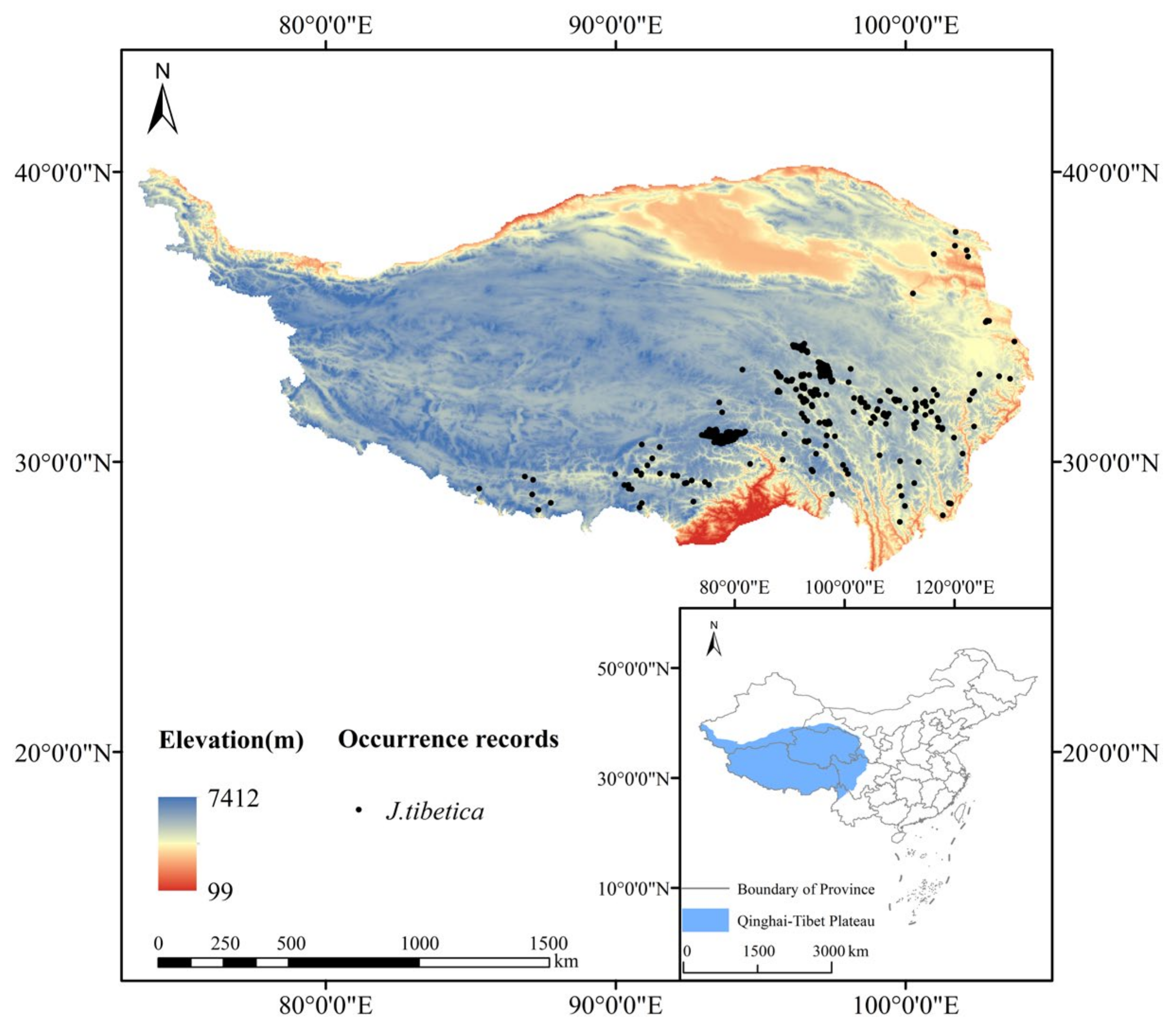

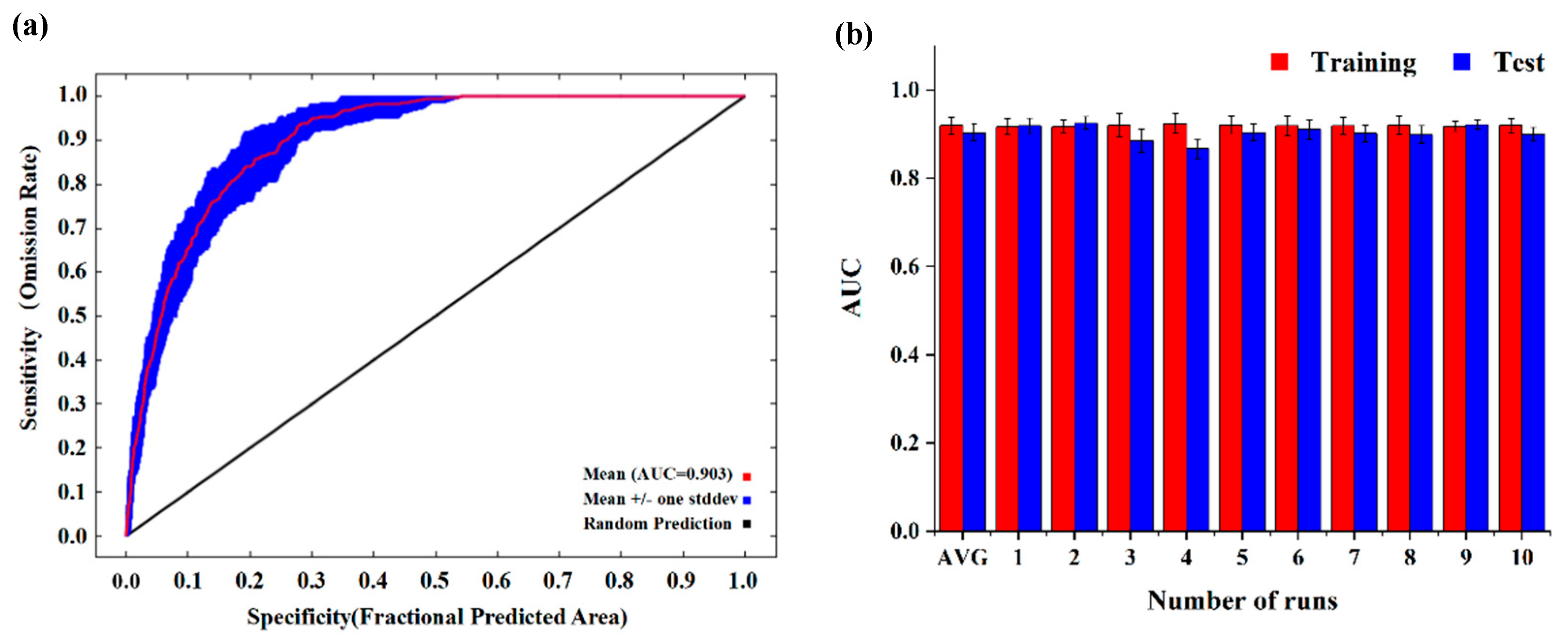
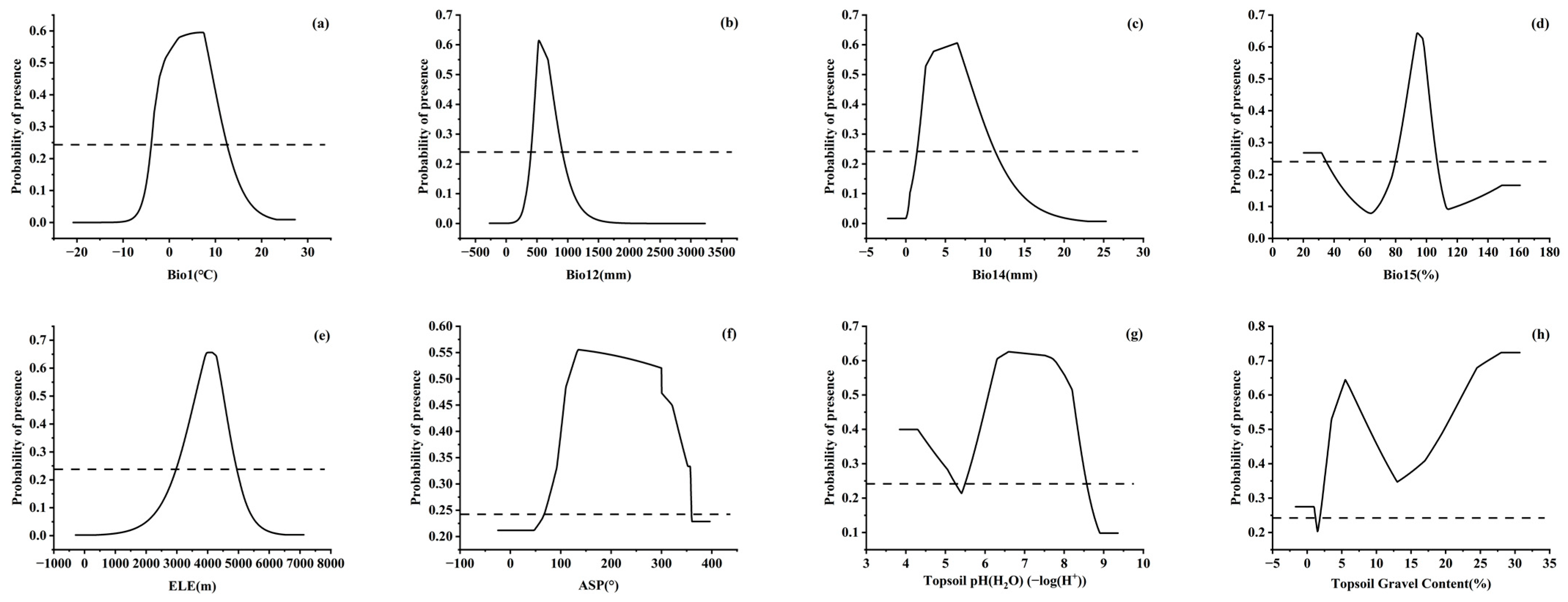


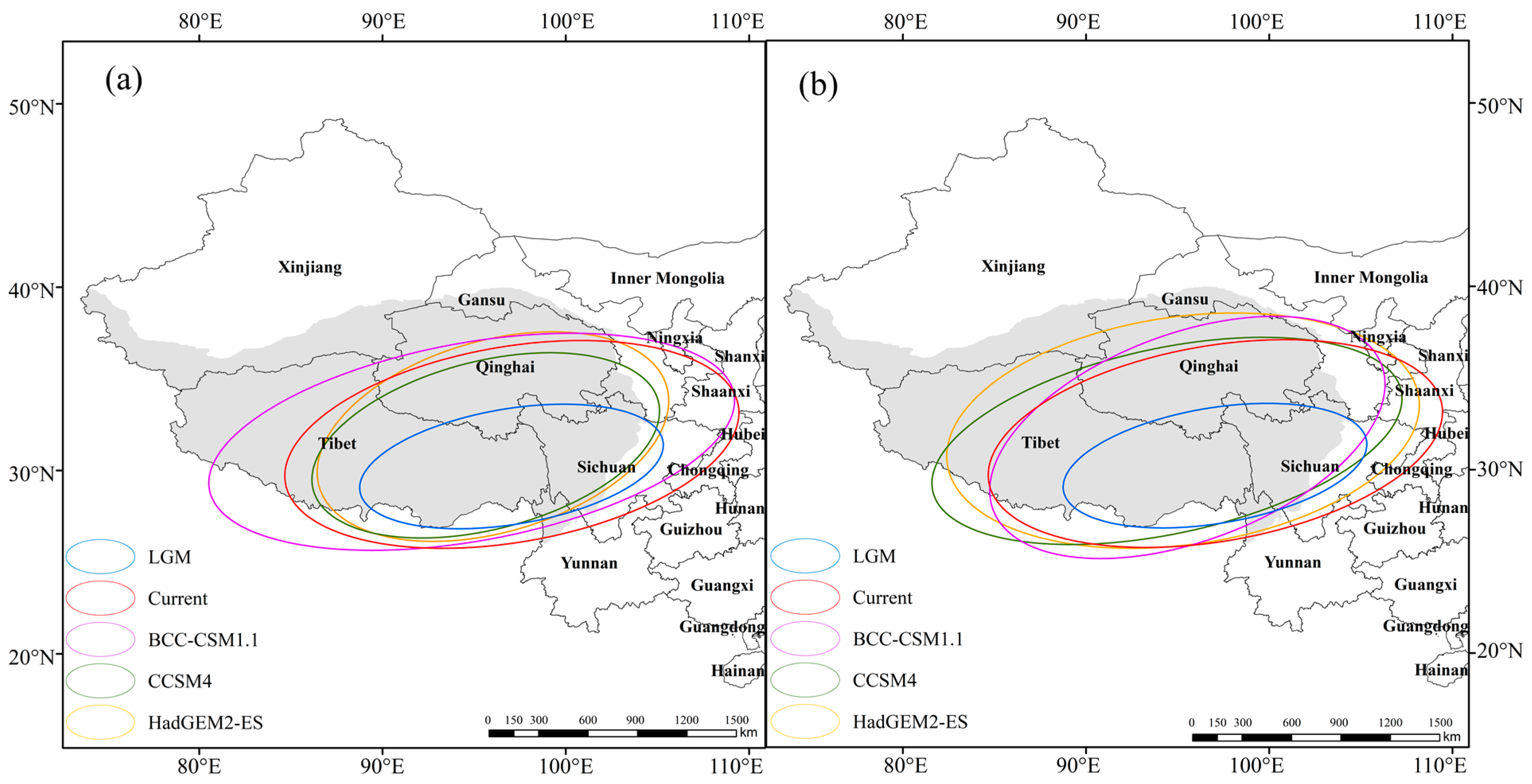
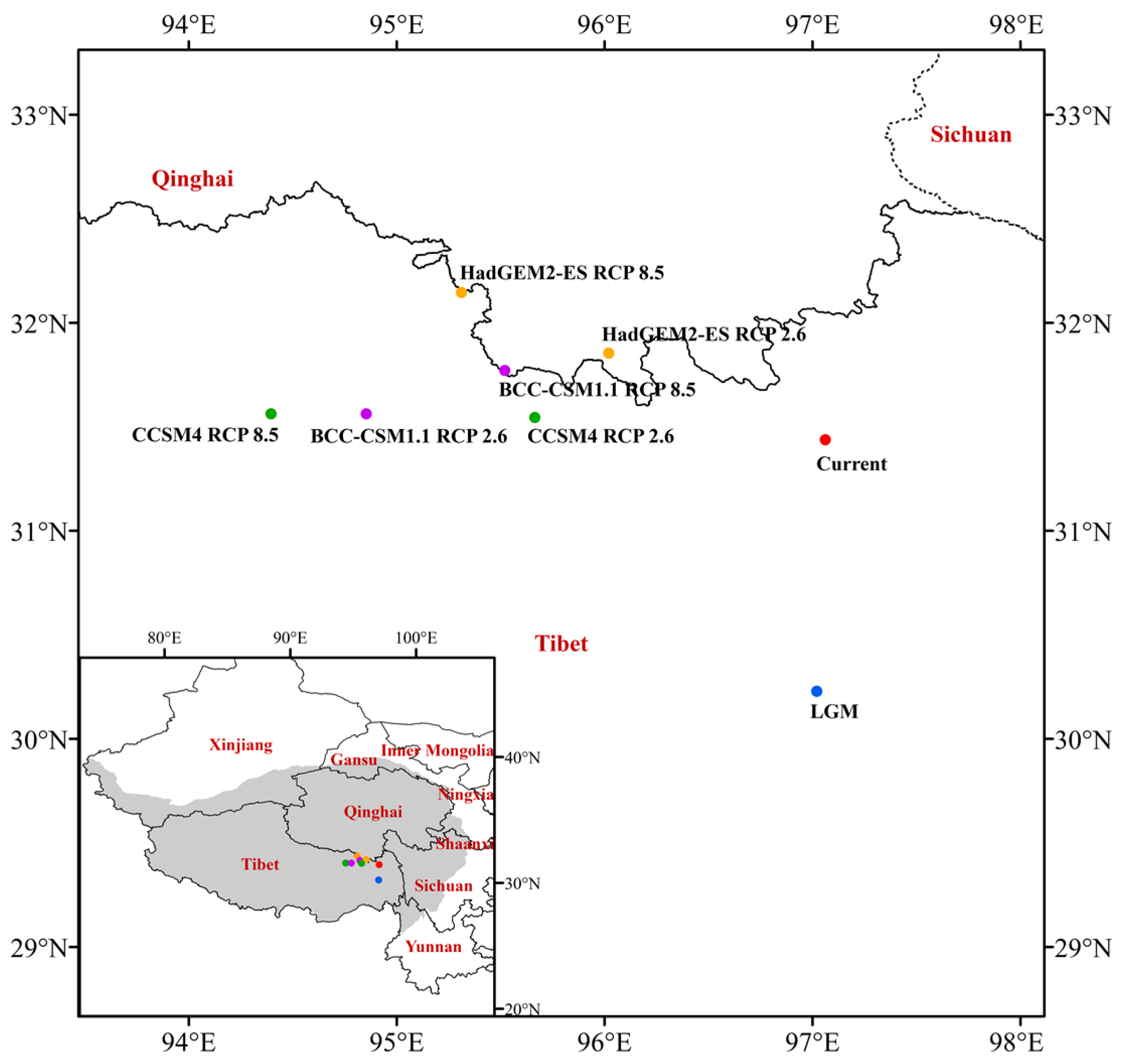
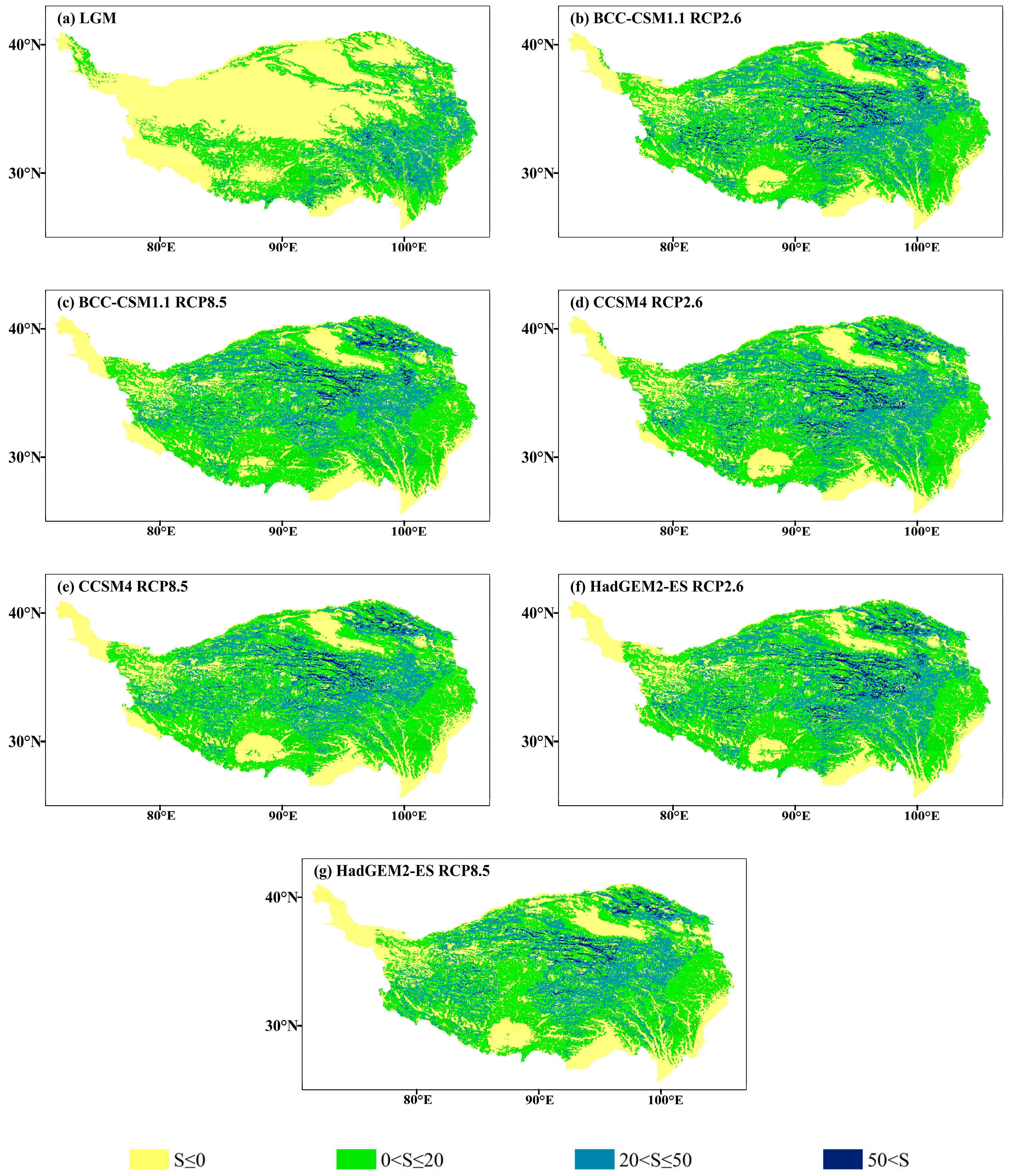
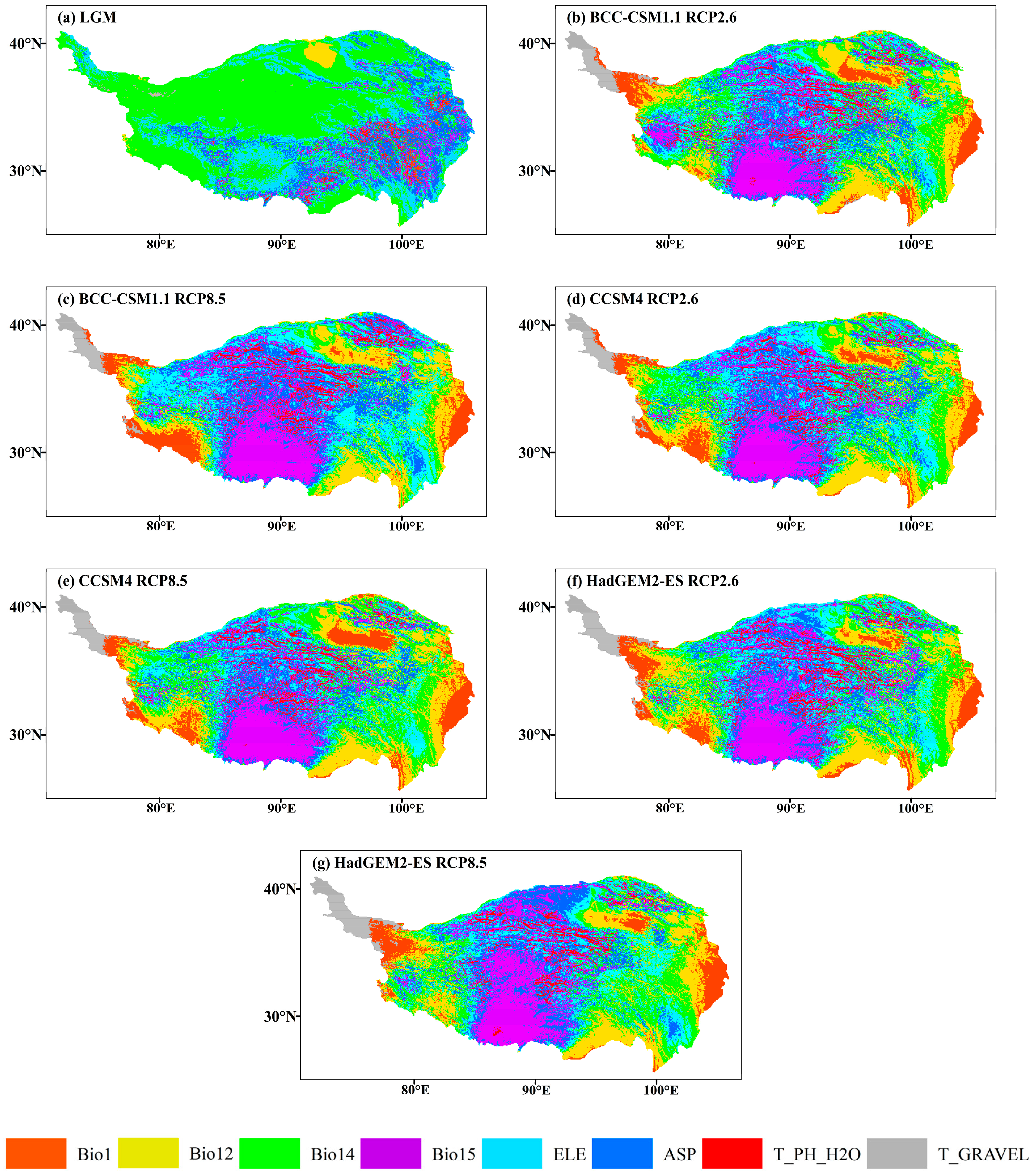
| Category | Variable | Implication | Unit | Source |
|---|---|---|---|---|
| Climate | Bio1 | Annual mean temperature | °C | http://www.worldclim.org (accessed on 22 April 2022) |
| Bio2 | Mean diurnal range | °C | ||
| Bio3 | Isothermality | \ | ||
| Bio4 | Temperature seasonality | \ | ||
| Bio5 | Max temperature of warmest month | °C | ||
| Bio6 | Min temperature of coldest month | °C | ||
| Bio7 | Temperature annual range | °C | ||
| Bio8 | Mean temperature of wettest quarter | °C | ||
| Bio9 | Mean temperature of driest quarter | °C | ||
| Bio10 | Mean temperature of warmest quarter | °C | ||
| Bio11 | Mean temperature of coldest quarter | °C | ||
| Bio12 | Annual precipitation | mm | ||
| Bio13 | Precipitation of wettest month | mm | ||
| Bio14 | Precipitation of driest month | mm | ||
| Bio15 | Precipitation seasonality | \ | ||
| Bio16 | Precipitation of wettest quarter | mm | ||
| Bio17 | Precipitation of driest quarter | mm | ||
| Bio18 | Precipitation of warmest quarter | mm | ||
| Bio19 | Precipitation of coldest quarter | mm | ||
| Terrain | ELE | Elevation | m | http://www.worldclim.org (accessed on 22 April 2022) |
| ASP | Aspect | ° | ||
| SLO | Slope | ° | ||
| Soil | T_PH_H2O | Topsoil pH (H2O) | −log (H+) | http://www.iiasa.ac.at/web/home/research/researchPrograms/water/HWSD.html (accessed on 13 May 2022) |
| T_GRAVEL | Topsoil gravel content | % | ||
| T_SILT | Topsoil silt fraction | % | ||
| T_CLAY | Topsoil clay fraction | % | ||
| T_BULK_DEN | Topsoil bulk density | kg/dm3 | ||
| T_SAND | Topsoil sand fraction | % |
| Variable | VIF | Variable | VIF |
|---|---|---|---|
| Bio1 | 2.99 | ELE | 1.01 |
| Bio12 | 1.85 | ASP | 1.00 |
| Bio14 | 3.74 | T_PH_H2O | 2.34 |
| Bio15 | 2.46 | T_GRAVEL | 1.68 |
| PC (%) | PI (%) | RTGW | RTGO | TGW | TGO | AUCW | AUCO | |
|---|---|---|---|---|---|---|---|---|
| Bio1 | 7.1657 | 21.1592 | 1.1596 | 0.3529 | 1.2032 | 0.3692 | 0.8961 | 0.7140 |
| Bio12 | 68.2146 | 45.5314 | 1.101 | 0.8572 | 1.1572 | 0.8875 | 0.8907 | 0.8520 |
| Bio14 | 1.6127 | 7.0394 | 1.1942 | 0.4260 | 1.2084 | 0.4423 | 0.8986 | 0.7498 |
| Bio15 | 8.4976 | 10.4002 | 1.1611 | 0.4290 | 1.1667 | 0.4863 | 0.8963 | 0.7738 |
| ELE | 6.3527 | 8.3450 | 1.1909 | 0.3452 | 1.2239 | 0.3664 | 0.9022 | 0.7424 |
| ASP | 1.1041 | 0.9390 | 1.2142 | 0.0556 | 1.2691 | 0.0425 | 0.9041 | 0.5910 |
| T_PH_H2O | 4.1193 | 3.4303 | 1.1897 | 0.1837 | 1.2450 | 0.1958 | 0.9046 | 0.6744 |
| T_GRAVEL | 2.9334 | 3.1554 | 1.1877 | 0.1388 | 1.2501 | 0.1508 | 0.9034 | 0.6691 |
| Period | LGM | Current | BCC-CSM1.1 | CCSM4 | HadGEM2-ES | |||
|---|---|---|---|---|---|---|---|---|
| RCP2.6 | RCP8.5 | RCP2.6 | RCP8.5 | RCP2.6 | RCP8.5 | |||
| Unsuitable habitat | 251.03 | 198.00 | 211.55 | 198.19 | 222.39 | 205.98 | 213.84 | 196.93 |
| Marginally suitable habitat | 1.54 | 31.37 | 9.07 | 8.69 | 7.39 | 8.12 | 7.53 | 9.74 |
| Moderately suitable habitat | 3.65 | 19.22 | 25.34 | 27.21 | 19.44 | 24.98 | 23.79 | 30.74 |
| Highly suitable habitat | 1.02 | 8.65 | 11.28 | 23.15 | 8.02 | 18.17 | 12.07 | 19.83 |
| Total suitable habitat | 6.21 | 59.24 | 45.69 | 59.05 | 34.85 | 51.26 | 43.39 | 60.31 |
| Period | Decreased Area | Invariant Area | Increased Area |
|---|---|---|---|
| LGM | 0.04 | 204.14 | 53.07 |
| BCC-CSM1.1_RCP2.6 | 24.71 | 221.37 | 11.16 |
| BCC-CSM1.1_RCP8.5 | 21.00 | 215.43 | 20.81 |
| CCSM4_RCP2.6 | 29.14 | 223.34 | 4.76 |
| CCSM4_RCP8.5 | 25.25 | 214.71 | 17.28 |
| HadGEM2-ES_RCP2.6 | 25.50 | 222.08 | 9.66 |
| HadGEM2-ES_RCP8.5 | 22.62 | 210.92 | 23.69 |
| Period | Center | XStdDist | YStdDist | Rotation | Oblateness |
|---|---|---|---|---|---|
| LGM | 97.04° E, 30.22° N | 8.38 | 3.15 | 80.43 | 0.62 |
| Current | 97.06° E, 31.42° N | 12.54 | 5.33 | 80.30 | 0.57 |
| BCC-CSM1.1 RCP2.6 | 94.86° E, 31.57° N | 14.55 | 5.40 | 79.69 | 0.63 |
| BCC-CSM1.1 RCP8.5 | 95.53° E, 31.76° N | 11.31 | 5.65 | 69.62 | 0.50 |
| CCSM4 RCP2.6 | 95.63° E, 31.54° N | 9.72 | 4.58 | 75.62 | 0.53 |
| CCSM4 RCP8.5 | 94.42° E, 31.57° N | 13.07 | 5.06 | 77.94 | 0.61 |
| HadGEM2-ES RCP2.6 | 96.03° E, 31.85° N | 9.87 | 5.22 | 73.93 | 0.47 |
| HadGEM2-ES RCP8.5 | 95.29° E, 32.13° N | 12.99 | 6.21 | 81.96 | 0.52 |
Disclaimer/Publisher’s Note: The statements, opinions and data contained in all publications are solely those of the individual author(s) and contributor(s) and not of MDPI and/or the editor(s). MDPI and/or the editor(s) disclaim responsibility for any injury to people or property resulting from any ideas, methods, instructions or products referred to in the content. |
© 2023 by the authors. Licensee MDPI, Basel, Switzerland. This article is an open access article distributed under the terms and conditions of the Creative Commons Attribution (CC BY) license (https://creativecommons.org/licenses/by/4.0/).
Share and Cite
Zhang, H.; Zhao, B.; Huang, T.; Chen, H.; Yue, J.; Tian, Y. Responses of the Distribution Pattern of the Suitable Habitat of Juniperus tibetica Komarov to Climate Change on the Qinghai-Tibet Plateau. Forests 2023, 14, 434. https://doi.org/10.3390/f14020434
Zhang H, Zhao B, Huang T, Chen H, Yue J, Tian Y. Responses of the Distribution Pattern of the Suitable Habitat of Juniperus tibetica Komarov to Climate Change on the Qinghai-Tibet Plateau. Forests. 2023; 14(2):434. https://doi.org/10.3390/f14020434
Chicago/Turabian StyleZhang, Huayong, Bingjian Zhao, Tousheng Huang, Hao Chen, Junjie Yue, and Yonglan Tian. 2023. "Responses of the Distribution Pattern of the Suitable Habitat of Juniperus tibetica Komarov to Climate Change on the Qinghai-Tibet Plateau" Forests 14, no. 2: 434. https://doi.org/10.3390/f14020434
APA StyleZhang, H., Zhao, B., Huang, T., Chen, H., Yue, J., & Tian, Y. (2023). Responses of the Distribution Pattern of the Suitable Habitat of Juniperus tibetica Komarov to Climate Change on the Qinghai-Tibet Plateau. Forests, 14(2), 434. https://doi.org/10.3390/f14020434






